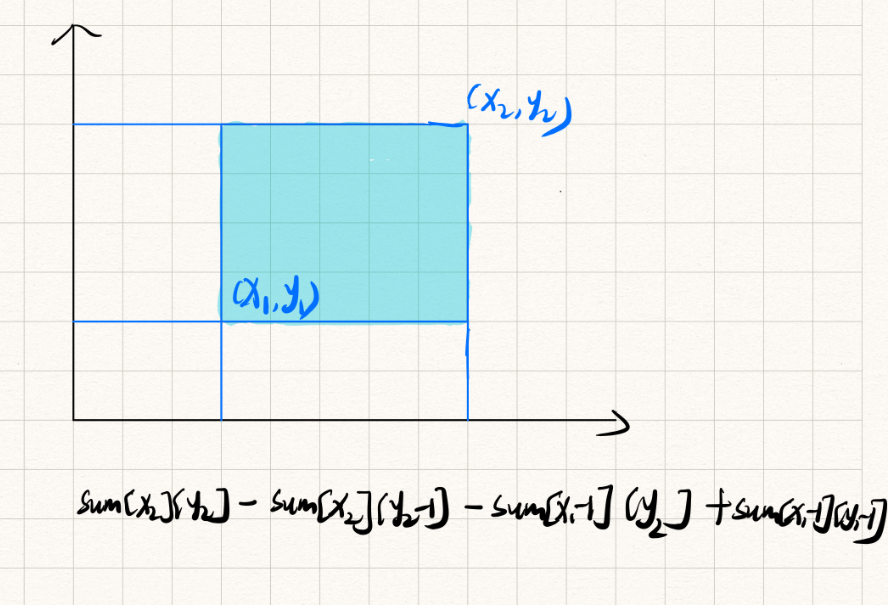P2163 [SHOI2007]园丁的烦恼
题目描述:
二维平面有n个坐标,每个坐标都表示该点处有一颗树苗,进行m次询问,每次询问给出两个坐标,表示一个矩形的左下角和右上角,输出这个矩形中的树苗的数量,包括矩形的边界
思路:
二维偏序天花板
二维偏序 + 容斥 + 离散化 + 树状数组 + 思维
做过前几个二维偏序的题后,这个题的思路就非常简单,其实就是求满足
的 的数量,其中 是输入的n个树苗的点, 是询问矩形的左下角和右上角,很容易的就可以联想到用前缀和来处理,但是因为是二维的,所以是需要容斥的,和二维前缀和的容斥一样,如下: 这样其实就近似转换成求满足
的 (i,j)的数量,那这不就是二维偏序了吗,由于这个n个点的坐标和这m次询问的坐标并不会完全重合,所以我们需要存下所有的询问,离线处理我第一遍写的时候是将
n个点和4m个询问的点都放在里一起进行排序然后用树状数组,但是由于离线 + 容斥了,就非常混乱,后来看一个很妙的思路就是分开排序,就是对n个点按x排,4m个点也按x排,用树状数组计算答案的时候,去遍历4m个点,用一个while循环先去尽可能插能插进去的点,再询问,就很妙,而且对于m次询问来说,将每次的询问拆成了如下的四部分:,处理的方式如下: for(int i = 1; i <= m; ++i){ x1 = IntRead();y1 = IntRead(); x2 = IntRead();y2 = IntRead(); ++tot;ar[tot].id = tot;ar[tot].x = x2;ar[tot].y = y2; ++tot;ar[tot].id = tot;ar[tot].x = x2;ar[tot].y = y1 - 1; ++tot;ar[tot].id = tot;ar[tot].x = x1 - 1;ar[tot].y = y2; ++tot;ar[tot].id = tot;ar[tot].x = x1 - 1;ar[tot].y = y1 - 1; }将一个询问拆成四个,统计答案的时候就直接
for(int i = 1; i <= tot; i += 4){ printf("%d\n", ans[i] + ans[i + 3] - ans[i + 1] - ans[i + 2]); }再有就是这个题的坐标的范围达到了
1e7,巨大,需要离散化(不离散化吸口氧也行其实),因为先通过排序降掉了第一维,所以我们只需要离散化第二维y即可,用vector排序去重二分来进行离散化操作,剩下的就是树状数组操作了,注意树状数组的update操作要跑到n + 2 * m,因为离散化后最多有n + 2 * m个数还有就是只需要对x排序,不需要对y进行排序,不然不吸氧是过不去的
//Work by: Chelsea
#include <bits/stdc++.h>
using namespace std;
#define endl '\n'
#define inf 0x3f3f3f3f
#define mod 1000000007
#define sd(n) scanf("%d",&n)
#define sdd(n,m) scanf("%d %d",&n,&m)
#define m_p(a,b) make_pair(a, b)
#define mem(a,b) memset((a),(b),sizeof(a))
#define rep(i,a,b) for(int i=(a);i<=(b);i++)
#define io ios::sync_with_stdio(false); cin.tie(0); cout.tie(0)
typedef long long ll;
typedef pair <int,int> pii;
inline int IntRead(){char ch = getchar();int s = 0, w = 1;while(ch < '0' || ch > '9'){if(ch == '-') w = -1;ch = getchar();}while(ch >= '0' && ch <= '9'){s = s * 10 + ch - '0';ch = getchar();}return s * w;}
#define y1 y114514
#define MAX 2000000 + 50
int n, m, k, op;
int x1, x2, y1, y2;
struct ran{
int x, y;
}tr[MAX];
bool cmp(ran a, ran b){
if(a.x != b.x)return a.x < b.x;
else return a.y < b.y;
}
int tot;
struct ranran{
int x, y, id;
}ar[MAX];
bool cmpp(ranran a, ranran b){
if(a.x != b.x)return a.x < b.x;
else return a.y < b.y;
}
int sum[MAX];
inline int lowbit(int x){
return x & (-x);
}
inline int getans(int i){
int ans = 0;
while (i) {
ans += sum[i];
i -= lowbit(i);
}
return ans;
}
inline void insert(int i, int c){
while (i <= n + 2 * m) {
sum[i] += c;
i += lowbit(i);
}
}
int ans[MAX];
void work(){
n = IntRead();m = IntRead();
vector<int>v;
for(int i = 1; i <= n; ++i){
tr[i].x = IntRead();tr[i].y = IntRead();
v.push_back(tr[i].y);
}
for(int i = 1; i <= m; ++i){
x1 = IntRead();y1 = IntRead();
x2 = IntRead();y2 = IntRead();
v.push_back(y2);v.push_back(y1 - 1);
++tot;ar[tot].id = tot;ar[tot].x = x2;ar[tot].y = y2;
++tot;ar[tot].id = tot;ar[tot].x = x2;ar[tot].y = y1 - 1;
++tot;ar[tot].id = tot;ar[tot].x = x1 - 1;ar[tot].y = y2;
++tot;ar[tot].id = tot;ar[tot].x = x1 - 1;ar[tot].y = y1 - 1;
}
sort(tr + 1, tr + 1 + n, cmp);
sort(ar + 1, ar + 1 + tot, cmpp);
sort(v.begin(), v.end());
v.erase(unique(v.begin(), v.end()), v.end());
int cnt = 1;
for(int i = 1; i <= tot; ++i){
while (cnt <= n && tr[cnt].x <= ar[i].x) {
int p = (int)(lower_bound(v.begin(), v.end(), tr[cnt].y) - v.begin());
insert(p + 1, 1);
++cnt;
}
int p = (int)(lower_bound(v.begin(), v.end(), ar[i].y) - v.begin());
ans[ar[i].id] += getans(p + 1);
}
for(int i = 1; i <= tot; i += 4){
printf("%d\n", ans[i] + ans[i + 3] - ans[i + 1] - ans[i + 2]);
}
}
int main(){
work();
return 0;
}

